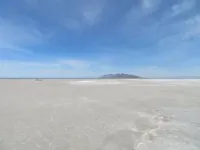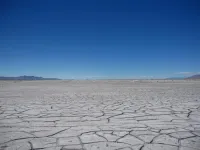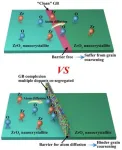(Press-News.org) A gentle rumble ran under Ngan Huang’s feet as a rocket carrying her research—live, human muscle cells grown on scaffolds fixed on tiny chips—lifted off, climbed, and disappeared into the sky to the International Space Station National Laboratory. These chips would help Huang better understand muscle impairment, often seen in astronauts and older adults, and test drugs to counter the condition.
Now, the results are back. Reporting in a study published July 25 in Stem Cell Reports, Huang’s team showed that space-travelling muscle had metabolic changes that indicate impaired muscle regeneration and gene activities associated to age-related muscle loss called sarcopenia. But drug treatment partially prevented microgravity’s adverse effects.
“Space is a really unique environment that accelerates qualities associated with aging and also impairs many healthy processes,” says Huang (@NganHuang), an associate professor at Stanford University. “Astronauts come back with muscle atrophy, or a reduction of muscle function, because the muscle isn’t being actively used in the absence of gravity. As space travel becomes more common and available to civilians, it’s important to understand what happens to our muscle in microgravity.”
To understand the effects of microgravity on muscles, the researchers launched muscle chips—bioengineered packages of oriented muscle cells on patterned biomaterials that mimic the structure of real muscles—into space to grow for seven days under astronauts’ care.
When the researchers compared muscle cells grown in microgravity to those grown on Earth, they found impaired muscle fiber formation. They also discovered differences in their gene activity and protein profile. Genes related to mitochondrial function, which muscles get their energy from, were compromised, and genes associated with fat formation were boosted. These findings suggest microgravity can lead to dysfunctions in muscle regeneration.
Space-traveled muscles also have gene activities that somewhat resemble muscles with sarcopenia, which most commonly affects people ages 60 and older.
“We think our research on muscle chips in microgravity may have broader implications on sarcopenia,” says Huang. “Sarcopenia usually takes decades to develop on Earth, and we think that microgravity may have some ability to accelerate the disease process in orders of days.”
In a proof-of-concept experiment to test the muscle chip for drug screening, the astronauts spiked the chips with drugs to treat sarcopenia or enhance muscle regeneration. The treatment partially mitigated some of the negative effects of microgravity on the muscles, preventing a metabolic shift to fat formation. Looking into gene activity patterns, the drug-treated muscle in microgravity is more similar to samples from Earth than untreated samples in microgravity.
Because space research is labor and resource intensive, the current study is a one-time experiment, and a limited number of samples were allowed to board the rocket. The scientists are now deploying equipment that simulates microgravity to overcome some of those limitations and aid their research in space. Huang’s muscle chips are scheduled to embark on another space journey in 2025 to continue the research on identifying drugs for treating microgravity-induced impairment in muscle regeneration.
“This concept of engineered tissue chip platform in microgravity is a potentially transformative tool that could allow us to study a variety of diseases and do drug screening without animal or human subjects,” says Huang.
###
This work was supported by the US National Institutes of Health, the US Department of Veterans Affairs, the National Science Foundation, the Center for the Advancement of Science in Space, the American Heart Association, the US Department of Veterans Affairs.
Stem Cell Reports, Kim, Ayan, and Shayan et al. “Skeletal Muscle-On-A-Chip in Microgravity As a Platform for Regeneration Modeling and Drug Screening” https://www.cell.com/stem-cell-reports/fulltext/S2213-6711(24)00190-5
Stem Cell Reports (@stemcellreports), published by Cell Press for the International Society for Stem Cell Research (@ISSCR), is a monthly open-access peer-reviewed publication communicating basic discoveries across the spectrum of stem cell research and translational and clinical studies. The journal focuses on shorter, single-point manuscripts that report original research with conceptual or practical advances that are of broad interest to scientists and clinicians across the continuum of stem cell science and application. Visit http://www.cell.com/stem-cell-reports. To receive Cell Press media alerts, please contact press@cell.com.
END
Findings from a small, proof-of-concept clinical trial have suggested that fecal microbiota transplants (FMTs) can boost the effectiveness of immunotherapy in a range of gastrointestinal cancers. In the study, published July 25 in the journal Cell Host & Microbe, six of 13 patients who had previously shown resistance to immune checkpoint inhibitors benefited from receiving FMTs from donors who had previously responded to treatment. The investigators also identified specific strains of bacteria associated with better or worse responses to FMT and immune checkpoint drugs.
“This research highlights the complex interplay between beneficial ...
Newly announced research by Royal Ontario Museum (ROM) examining greenhouse gas emissions from the drying lake bed of Great Salt Lake, Utah, calculates that 4.1 million tons of carbon dioxide and other greenhouse gases were released in 2020. This research suggests that drying lake beds are an overlooked but potentially significant source of greenhouse gases, which may further increase due to climate change. These results were announced in the paper, “A desiccating saline lake bed is a significant source of anthropogenic greenhouse gas emissions,” published in the journal One Earth.
“Human-caused ...
About The Study: Hospitals in communities with the greatest level of socioeconomic disadvantage had the lowest likelihood of becoming stroke certified while hospitals in the most advantaged communities had the highest likelihood in this cohort study. These findings suggest that there is a need to support hospitals in disadvantaged communities to obtain stroke certification as a way to reduce stroke disparities.
Corresponding Author: To contact the corresponding author, Renee Y. Hsia, M.D., M.Sc., email renee.hsia@ucsf.edu.
To access the embargoed study: Visit our For The Media website at this link ...
About The Study: This cohort study indicates that the risk of dying of breast cancer increases substantially after experiencing a contralateral breast cancer. Women with breast cancer treated with bilateral mastectomy had a greatly diminished risk of contralateral breast cancer; however, they experienced similar mortality rates as patients treated with lumpectomy or unilateral mastectomy.
Corresponding Author: To contact the corresponding author, Steven A. Narod, M.D., email steven.narod@wchospital.ca.
To access the embargoed study: Visit our For The Media website at this link https://media.jamanetwork.com/
(doi:10.1001/jamaoncol.2024.2212)
Editor’s ...
TMDU researchers demonstrate proof of concept of antisense nucleic acid therapy to prevent the spread of α-synuclein pathologies in synucleinopathies.
Tokyo, Japan – Parkinson’s disease (PD), as well as many other neurodegenerative disorders, has shown a link between the abnormal aggregation of a protein called α-synuclein (aSyn) and neuronal death. These aggregates, known as Lewy bodies and Lewy neurites depending on their subcellular localization, can spread by continuously causing normal endogenous aSyn to misfold. The complex nature of this aggregation process poses significant challenges ...
Designing the spatial arrangement of underground powerhouses involves numerous complex parameters and boundaries, requiring frequent reference to various cases and specifications. Traditional methods struggle to efficiently retrieve this information, leading to suboptimal designs and extended project timelines. Due to these challenges, there is a pressing need for a more intelligent and efficient approach to streamline the design process, enhance accuracy, and improve project management in hydropower engineering.
Researchers from Tianjin University, in collaboration with PowerChina Kunming Engineering Corporation Limited and other ...
Perovskite solar cells (PSCs) are highly regarded for their exceptional performance and straightforward fabrication. However, traditional hole transport layers (HTLs) like Poly (triarylamine) (PTAA), Nickel Oxide (NiOx), and poly (3,4-ethylenedioxythiophene)-poly (styrenesulfonate) (PEDOT) have inherent limitations that impede efficiency and stability. These materials often suffer from issues such as hydrophobicity, high reactivity, and acidity, which negatively affect the overall performance of PSCs. Due to these challenges, there is a pressing ...
To achieve carbon neutrality, advancements in energy conversion and storage technologies are essential. Current aqueous energy devices suffer from performance limitations due to the trade-off between permeability and selectivity in permselective membranes. This trade-off hampers the efficiency of energy conversion and storage systems, necessitating the development of membranes that can balance these properties effectively. Due to these challenges, further research is required to explore innovative membrane structures that can enhance the performance of energy conversion and storage devices.
A research team from Tsinghua University has published a study (DOI: 10.26599/EMD.2024.9370041) ...
Perovskite solar cells (PSCs) are celebrated for their exceptional photovoltaic performance and affordability. However, the high cost of charge transport materials remains a major obstacle to their commercialization. Conventional materials like 2,2',7,7'-Tetrakis[N,N-di(4-methoxyphenyl)amino]-9,9'-spirobifluorene (Spiro-OMeTAD), are expensive and complex to produce. Therefore, developing low-cost, efficient alternatives is essential to make PSCs more economically viable. Addressing these issues is crucial for advancing solar technology and achieving broader adoption. Hence, this study focuses ...
To date, ceramic scientists have devised various strategies to impede grain coarsening. The utilization of nano-sized precursor powder can not only facilitate the densification process, but also yields bulk ceramics with reduced grain sizes compared with micron-sized precursor powder. Rapid sintering by passes the low-temperature surface diffusion stage and directly enters the high-temperature sintering stage through rapid heating, rendering it an effective way to inhibit grain coarsening. However, these aforementioned strategies fail to prevent coarsening during the application of nano-ceramics in medium- ...









